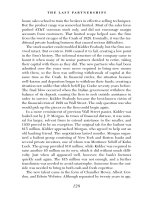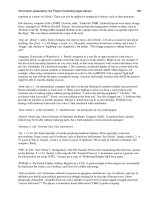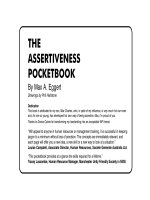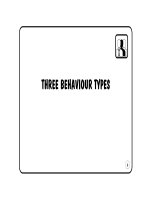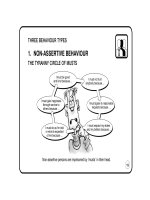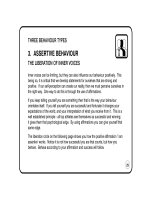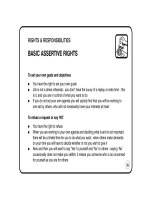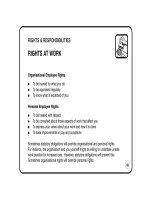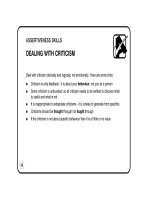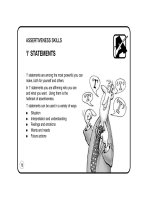THE BALANCE SHEET POCKET BOOK phần 5 docx
Bạn đang xem bản rút gọn của tài liệu. Xem và tải ngay bản đầy đủ của tài liệu tại đây (223.38 KB, 12 trang )
CLASSIFICATION OF EXPENDITURE
CONTROL
REVENUE EXPENDITURE
● Businesses have limited resources
● Plans have to be made and resources allocated to the activities and expenditures
required to meet the business aims
● Actual expenditure is compared with planned expenditure to identify
any differences (variances)
● Action must then be taken either to:
i) bring expenditure back in line with budget, or ii) amend the budget
See further The Managing Budgets Pocketbook
40
PLANNED EXPENDITURE ACTUAL EXPENDITURE
IDENTIFY VARIANCES
COMPARE
ACTION
?
?
FINANCIAL REPORTS
page
Introduction 42
Section 1: The Balance Sheet 45
Section 2: The Profit and Loss Account 69
41
FINANCIAL REPORTS
INTRODUCTION
Here is the Business Financial Model as developed in the first section of the
pocketbook. p31
BUSINESS FINANCIAL MODEL
● Funds are raised to finance
the planned investment
● Funds are used in support
of the Business Plan
● Assessment of Profit
Performance - a measure of
the effectiveness with which
this investment has been used
in order to generate profits
42
SOURCE OF FUNDS
USE OF FUNDS
SHARE CAPITAL LOAN CAPITAL RETAINED PROFITS
PRODUCTS / SERVICES
WORKING CAPITAL
Sales
Attributable Cost
Operating Profit
Interest
Tax
Earnings
Dividend
Retained Profits
Less:
Less:
Less:
Depreciation
FACILITIES / PROCESSES
FIXED ASSETS
FINANCIAL REPORTS
INTRODUCTION
The business must provide information in the form of financial reports to the
owners - the shareholders.
These reports include:
i) a summary of the business investment
a Balance Sheet
ii) a summary of the operating performance
the Profit and Loss Account
43
FINANCIAL REPORTS
INTRODUCTION
The Balance Sheet and Profit and Loss Account are reports of the Business Financial Model:
THE LINK TO THE BUSINESS FINANCIAL MODEL
44
SOURCE OF FUNDS
USE OF FUNDS
SHARE CAPITAL LOAN CAPITAL RETAINED PROFITS
PRODUCTS / SERVICES
WORKING CAPITAL
Sales
Attributable Cost
Operating Profit
Interest
Tax
Earnings
Dividend
Retained Profits
Less:
Less:
Less:
Depreciation
FACILITIES / PROCESSES
FIXED ASSETS
Report 1
Report 2
THE
BALANCE
SHEET
PROFIT
and
LOSS
ACCOUNT
A summary of investment
in the business at a
specific point in time
A summary of Profit
Performance covering
a stated Trading Period
}
}
SECTION 1
THE BALANCE SHEET
Page
Introduction 46
Use of Funds:
Fixed Assets (including Depreciation) 48
Working Capital 51
Source of Funds 53
The Balancing Act 56
Summary 59
Published Format 65
45
THE BALANCE SHEET
INTRODUCTION
The Balance Sheet is:
● A financial statement of the business investment as at a specific point in time; and
● Reports at the specific point in time
- where the money invested in the business came from SOURCE OF FUNDS
- and how it is currently invested USE OF FUNDS
46
SOURCE OF FUNDS
USE OF FUNDS
SHARE CAPITAL LOAN CAPITAL RETAINED PROFITS
FIXED ASSETS
ie:
FACILITIES & PROCESSES
WORKING CAPITAL
ie:
PRODUCTS & SERVICES
BALANCE SHEET
Financial picture
at a
point in time
THE BALANCE SHEET
FORMAT
The Balance Sheet format swops the two halves of the model over:
● Use of Funds appears at the top of the statement
● Source of Funds appears at the bottom of the statement
Hence
47
Balance Sheet: ARC plc as at 31st December 200-
£
Use of Funds
Fixed Assets
Working Capital __________
__________
Source of Funds
Share Capital
Retained Profits
Loan Capital __________
__________
THE BALANCE SHEET
FIXED ASSETS
VALUATION OF FIXED ASSETS
Fixed Assets are:
Facilities and Processes acquired for use in the business as a result of
Capital Expenditure p20
Fixed Assets are valued on the Balance Sheet at
48
£
Cost, to include:
purchase costs
legal costs
installation costs
Less:
Depreciation
__________
ie:
Net Book Value
(or Written Down Value) __________
THE BALANCE SHEET
FIXED ASSETS
DEPRECIATION OF FIXED ASSETS
By definition:
● Fixed Assets are used in the business for a period in excess of one year
● The cost of the Fixed Asset is considered significant given the scale
of the business operation
Charging capital expenditure against profits in the year of purchase would unfairly
penalise that year’s result and subsequent years, when the facility continued
to be used, would not bear any of the cost.
Therefore there needs to be a basis for apportioning the cost of the investment over
the years which will benefit from its use.
The resultant charge is called:
D E P R E C I A T I O N
49
THE BALANCE SHEET
DEPRECIATION OF FIXED ASSETS
Depreciation is not applied to land (with the exception of quarries and mines).
It is applied to
all other Fixed Assets:
50
THE BALANCE SHEET
WORKING CAPITAL
DEFINITION
The Funds used to provide the flow of materials, services and credit required to achieve
the sales and satisfy customer needs. p23
● Stock (Raw materials,
Work in Progress and
Finished Goods)
● Debtors/Receivables
(Amounts owed by customers)
● Cash
Less:
● Creditors/Payables
(Amounts owed to suppliers)
Equals Working Capital
51
CURRENT
ASSETS
CURRENT
LIABILITIES
}
}
